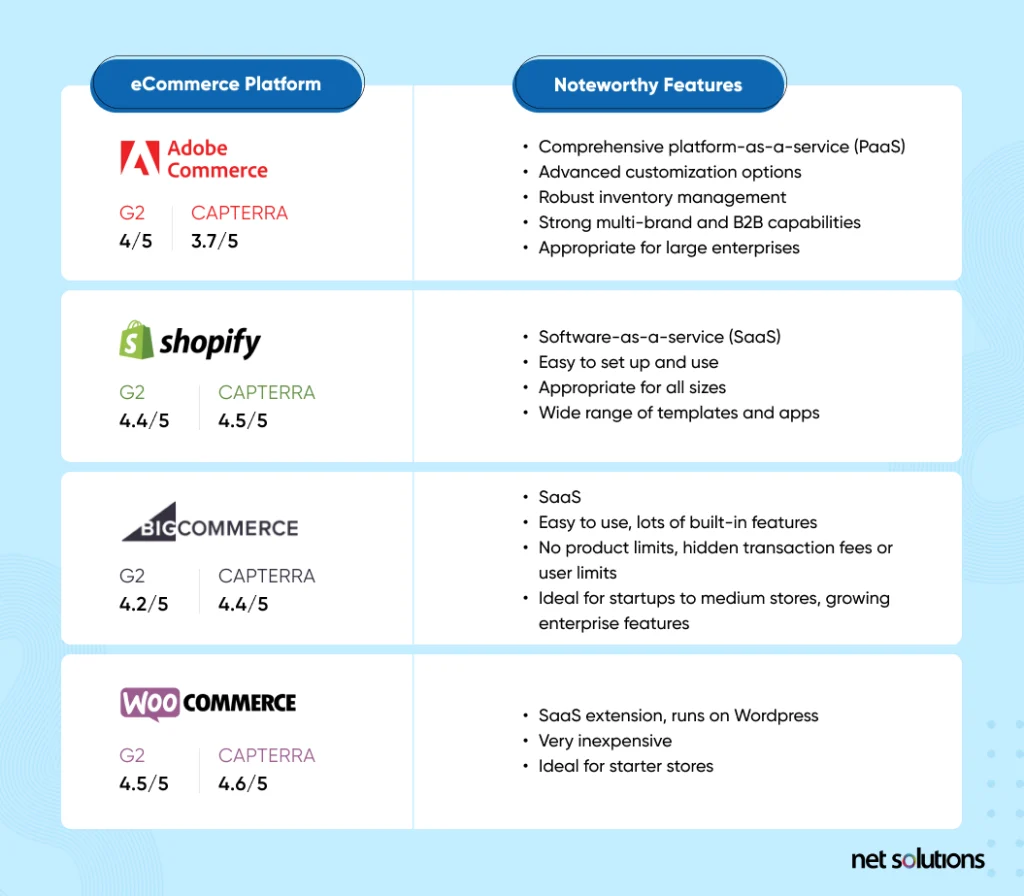Running and growing an online storefront starts first with choosing the right eCommerce platform. From Magento (now Adobe Commerce) to WooCommerce and BigCommerce, there are many options to choose from. Adobe Commerce is a eight-time Leader in digital commerce and is worth your strong consideration.
In this blog post, we’ll list the top 11 biggest benefits of Magento (both Magento Open Source and Adobe Commerce) to help eCommerce business owners, marketing managers, web developers, entrepreneurs make an informed decision for their online store.
The 11 Biggest Benefits of Magento (Adobe Commerce) for eCommerce Brands
The Magento eCommerce platform is an advanced content management system (CMS), created as an open-source eCommerce platform to create and manage a scalable digital storefront. Today, Adobe maintains and contributes to Magento Open Source, to empower small businesses and developers, with the ultimate goal being a transition to Adobe’s all-in-one enterprise edition, Adobe Commerce.
Adobe leverages a composable commerce strategy, including core capabilities (i.e. those in Magento Open Source) with packaged business services of advanced capabilities and the ability to extend further with microservices and apps. To understand more about the features of Magento in detail and all the various editions and price tiers, we welcome you to read our Guide to Adobe Commerce (Magento) or our detailed look at Magento features.
As a quick take, here are 11 of the biggest benefits you can expect from using Magento. Wherever relevant, we’ll break out the different benefits of Magento Open Source vs Adobe Commerce.
1. Scalability
It is critical to ensure your storefront is available and able to scale online shopping both over time and in response to sudden surges in traffic. Magento uses a modular architecture to enable scalability and optimize performance. In a self-hosted capacity, you need to plan for scalability by choosing a hosting provider capable of meeting your scaling needs and integrating your own content delivery network (CDN) to improve delivery.
Adobe Commerce is an all-in-one hosted solution that supports global scalability of your eCommerce site. Adobe Commerce offers continuous delivery of services, giving you the benefit of the latest infrastructure improvements and software. Adobe Commerce boasts a 99.99% uptime and includes the Fastly CDN to optimize delivery.

2. Customization
Tailor your store to perfectly match your brand and needs with the customizability of the Magento platform. Magento provides online merchants with flexibility to control the look, content and functionality of their eCommerce store. Customization options include customizing a theme or creating your own, customizing the store configuration (e.g. product attributes, checkout, payments), adding in modules or extensions to expand features to the platform, or integrating Magento with your internal systems.
For those embracing headless architecture, Magento helps drive continuous innovation and flexibility to integrate with a preferred frontend platform or build out customized digital touchpoints as well as embrace new services and capabilities quickly.
Note, any time you customize your store without pre-built integrations, extensions or modules, you run the risk of increasing the complexity and overall maintenance for your site, so plan accordingly.
3. Hosted or Open-Source
The same Magento eCommerce platform can be used as a free and open-source with Magento Open Source, giving you complete control over the code base, or as Adobe Commerce, with all of its enriched features and capabilities, available in on-premise and on cloud solutions.

4. Mobile-Friendly
Create a seamless shopping experience for customers wherever they are shopping: mobile devices, social media, online marketplaces, or physical spaces. Magento can be deployed traditionally, hybrid using a progressive web app (PWA) or headless to deliver seamless and optimized customer experiences across every channel and device, which is great for today’s mobile users.
Adobe Commerce customers can leverage PWA Studio, a part of the Adobe ecosystem, to accelerate time to market for PWAs that deliver native app-like experiences for both mobile and desktop devices.
5. Large Community
Get help and support from a vast network of users and developers who use and contribute to Magento. The rich and active Magento community helps maintain the integrity of Magento and contributes to the rich ecosystem of new themes, extensions and modules.
The Magento Association is the official community supporting Magento through collaboration, education and thought leadership, while Community Forums are popular on Adobe or unofficial groups on Reddit, Slack and other forums. Adobe also offers regular Community Hangouts to help users stay up to date with the latest platform updates and knowledge opportunities.
6. SEO-Friendly
Improve your search engine ranking and attract more traffic with effective search engine optimization (SEO) strategies. One of the goals in replacing Magento 1 with Magento 2 (a rebuild of the base eCommerce platform) was to improve SEO. Today, Magento provides full SEO features including SEO-friendly URLs, built-in URL rewrites, robots.txt, sitemap, metadata and more.
All of these features, when embraced, can help your store rank higher in search engine results pages (SERPs).
7. Third-party Integration
Easily connect with third-party services and marketplaces by searching the Adobe Commerce Marketplace, which lists vetted apps and extensions across a variety of commerce capabilities such as marketing, payment gateways (e.g. PayPal) and security, customer support, and shipping & fulfillment.
There are over 4,400 extensions available in the Marketplace that support both Magento Open Source and Adobe Commerce and an additional 2,820 extensions for Adobe Commerce on Cloud only. You can seamlessly also integrate a Magento store with extensions that expand channel availability to Amazon or Walmart.
8. Security
Protect your store and customer data with robust security features. Magento leverages strong data encryption to protect passwords and sensitive data (256-bit) and gives developers (via the admin panel) the ability to implement CAPTCHA or reCAPTCHA, implement two-factor authentication, and set up a security scan for each website (Magento Open Source or Adobe Commerce) to understand the real-time security status and receive suggestions to improve security. Scans can be scheduled to run daily, weekly or on demand. Adobe regularly releases patches and security updates for both Magento Open Source and Adobe Commerce.
Adobe Commerce on cloud operates on a shared responsibility model for security, with Adobe assuming responsibility for maintaining secure code, security of the platform, regularly testing backup and restore functionality, and ensuring the platform is SOC 2 and PCI DSS compliant. Adobe also provides documentation to help Commerce on Cloud customers are compliant with the latest privacy regulations.

9. Marketing Tools
Magento is an eCommerce solution that provides online merchants with extensive tools to create targeted campaigns, promote your store, increase conversion rates, and track results. Magento Open Source includes basic features for communications (email and newsletters), promotions, and managing user content (reviews), but Adobe Commerce adds significant improvements to the base platform.
Adobe Commerce includes native AI integration to improve Live Search, support omnichannel personalization using commerce data, support product recommendations, manage private sales, create related product rules, manage gift card accounts, and improve workflows with AI. Adobe Commerce also makes many of these features user-friendly for non-technical audiences. Learn more about the importance of eCommerce UX design practices and user experience design.

10. Advanced Reporting (Business Intelligence)
It is critical for large enterprises and global brands managing multiple global locations and currencies to have access to metrics and insights from data to make better business decisions and support business needs. Magento is a central solution that makes it easy to centralize all commerce data with data from other systems to help monitor business health. Both Magento Open Source and Adobe Commerce come with advanced reporting, though the number of reports is higher in Adobe Commerce.
Adobe Commerce includes rich visualization capabilities and robust reporting tools, with dashboards that can be customized, showing everything from average order value and sales to customer lifetime value, wish list insights, and retention rates. Reports can be scheduled and sent right to people’s inboxes.
11. Feature-Rich Platform
Magento includes powerful tools for content management, inventory management, marketing, analytics and more. Adobe Commerce includes all the base features of Magento Open Source with proprietary capabilities and unique benefits across all aspects of eCommerce website management for developers and for marketers:

New features are always being added to Adobe Commerce.
Note, for businesses that target or include B2B services, it is important to note that only Adobe Commerce features advanced B2B capabilities. Read more about How to Choose the Right B2B eCommerce Platform.
What Are Magento’s Benefits and Drawbacks Compared to Other eCommerce Platforms?
Apart from Adobe Commerce, there are other full-featured, hosted eCommerce platforms in the market such as Shopify, BigCommerce, and WooCommerce. We’ve put together a comparison table to help you narrow down the choices, providing context on how to choose the right eCommerce platform for you.

What Are the Challenges of Adopting Magento (Adobe Commerce) as Your eCommerce Platform?
The advantages of Magento are well-recorded, but when deciding on the ideal eCommerce CMS, it is critical to consider also the potential challenges associated with the choice. If you decide to use Magento, consider it is:
1. Slower on Smaller Servers
Magento Open Source requires a minimum of 2GB of RAM and on Apache or NGINX for optimal performance. Maento requires MySQL (AWS Aurora) and MariaDB. Magento Open Source runs only on Linux distributions. Adobe Commerce, when deployed on cloud, has fewer software dependencies and is optimized for performance at scale.
2. Technical Support
Given the level of flexibility in all aspects of Magento Open Source and Adobe Commerce, from the choice of traditional vs hybrid vs headless to design, integrations / third-party extensions and set-up, there is no question that Adobe Commerce requires a high level of technical support and website development expertise, either from an in-house team and/or the help of an expert Magento eCommerce development services. Adobe now offers Adobe Commerce Pro Managed Services, but at a very significant price, so alternative managed services may be a better fit for some enterprises.
3. Complicated for Beginners
Online retailers should know that both Magento Open Source and Adobe Commerce are advanced platforms that can involve a steep learning curve. Developers are required for both instances and in particular for the level of integrations and customizations involved.
While Magento Open Source can be deployed for small retailers, it should be noted that Adobe Commerce is designed for enterprise retailers and the price and features reflect these capabilities.
Over to You Now
We hope this list of the biggest benefits of Magento (Adobe Commerce) have given you some inspiration about what you can achieve when using Adobe Commerce to power your online store at scale.
Net Solutions is an award-winning Magento development company, offering Magento development services to help you create custom eCommerce experiences, whether you’re new to eCommerce or ready to switch to a platform at scale. Net Solutions is proud to offer Managed Services as an ongoing partner in your online business success.



